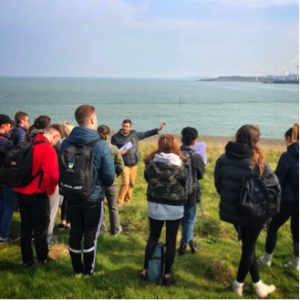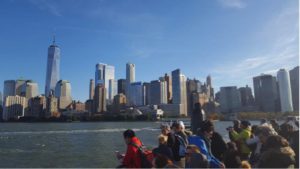
September 3, 2019, by Matt
Economic Geography in the Field
Field study has long been a vital component of geography as a discipline and plays a central role in geographical education and research throughout secondary schools and universities. Indeed, fieldwork has been viewed as an ‘initiation ritual of the discipline’ [1] and as a ‘locus of becoming’ [2] – it has come to define the geographer. Often field research is seen, primarily by non-geographers, as being the sole privilege of physical geographers and those more interested in the natural and environmental sciences. Such perceptions (mainly by non-geographers) are often negatively coloured by hazy memories of land-use surveys and shopping-centre pedestrian counts that pale into comparison for the secondary school student when contrasted with the apparent immediacy of standing chest-deep in a roaring Snowdonian stream experiencing ‘peak flow’.
Field learning, however, has had a long and rich history in the annals of economic geography and plays a crucial role in the development of technical and soft skills that are of tremendous value to employers. Since antiquity field work has been associated with explorations and mappings of various kinds and, latterly, as a way of exploring the complex relationships between people and their environments, the material practices of place making and the way in which these interactions, and others, sediment together often forming complex historical geographies.
Traditionally, human geography fieldwork emerged from what commentators and practitioners often refer to as the ‘stout boots tradition’ superbly outlined in an intervention from 1915 by the ‘father’ of US geography Carl Sauer [3]. In his somewhat militaristic set of exhortations, the field worker is encouraged to read thoroughly on the area being visited, acquire appropriate maps and ‘outline the campaign’ thoroughly and for all eventualities. Many of the field working methods and techniques in this tradition are linked to objective observation, whereby the field worker is removed from context and detached from the object of study. Such approaches have, quite correctly, been subjected to extended critique over the past 30 years or so by critical and feminist geographers for a lack of criticality in understanding the diverse power relationships that underpin field sites.
As an economic geographer with a history of teaching and researching in the field, in locations as diverse as the former Czechoslovakia, Italy, Germany, Northern Ireland, West Cumbria and, more recently, New York City, it can feel as though the importance of field work and field teaching for economic geography is somewhat neglected in the ‘big picture’ despite a rich tradition and a vibrant community of field teachers and researchers. As one of the UK’s leading centres for economic geography, doing economic geography ‘in the field’ at Nottingham, has become a vital part of engaging with the complexities of regional development, economic change and, of course, the profoundly geographical issue that is Brexit. It is only through the critical appreciation of certain sites and spatial formations that students can engage in the realities of economic geographical processes and ground these within the world in a practical sense.

Setting the Regional Scene: Learning about trade, Empire and Industrial Change in Workington, Cumbria (Photo courtesy of Thom Davies)
For example, our first year field course at Nottingham embeds the changing geographies of the regional economy into a series of projects and excursions on the Cumbrian Coast, an often ignored region that has experienced the full panoply of industrial and social change over the centuries. Up until the 1970s, the town of Workington was one of the global centres of the iron and steel industry and, until the 1960s, the coastline from Maryport in the North to Whitehaven in the South was defined by coal and iron ore mining. Students visiting a variety of sites can observe not only the impact that heavy industry has had on the physical landscape, but also see first-hand evidence of the various attempts to regenerate and revitalise the post-industrial landscape in light of the pit closures of the 1960s and the assault on the steel industry in the 1970s and 1980s. Somewhat inevitably, these have revolved around the presence of Sellafield as the major local employer and the role played various forms of renewable/sustainable energy in (re)branding the region as Britain’s Energy Coast. One of the most interesting, yet seemingly bland, sites we visit is a housing development on the outskirts of Whitehaven that used to be home to one of the largest chemical producers in Europe, Marchon. The site exemplifies economic change, processes of environmental contestation as well as debates around memory and loss.
Students gain a tremendous amount for observing and developing understanding first hand in the sites that are visited – adding value that simply cannot be replicated in the University classroom. For example, returning to the town of Whitehaven and its spectacular harbour, was once the second most important port in England, intimately linked to the global slave trade and being a major working port until the mid-1980s. By visiting the site and seeing both the relics of an industrial past and the attempts to repurpose the harbour as a leisure marina and tourist destination, important visual analyses can be conducted into the roles of heritage, urban planning, place-making and memorialisation and these can be used to make judgements as to the ‘archaeology of place’.
Developing these themes of using the landscape as a text that can be critically interpreted and creatively engaged with, are further developed in a number of final year field courses, to Berlin and New York City. Supported by seminars and small group teaching in the UK, students are encouraged to develop and research independent, creative projects in the field, under guidance from staff. These can range from exploring the role played by the creative and cultural economy in Berlin to the geographies of residential change in Manhattan’s Lower East Side. Overseas field visits such as these are inevitably seen as being the highpoint of a student’s learning journey in the School, especially given the spectacular and iconic nature of the urban landscapes that are being engaged with.
In my view, however, it is not merely spectacular and iconic landscapes that ‘make’ field work so rewarding. Indeed, the more mundane spaces and places closer to home are often just as interesting, if not more so. Building in a ‘field work’ mentality into everyday life is extremely valuable as being able to interpret and think critically about taken-for-granted spaces and places can shed rich illumination on ‘big’ abstract processes such as globalisation, immigration and economic inequality and other major issues that routinely make the national news.
Overall then, fieldwork is something that unites all geographers and represents a series of traditions that are unique to the discipline that, in turn, develop a unique and valuable set of critical skills. By realising that ‘the field’ is not ‘out there’ to be conquered and have a flag planted on it, but is something we are constantly embroiled and embedded in, is a vital part of developing our ideas of the world.
[1] Rose, G. (1993) Feminism and Geography: the Limits of Geographical Knowledge, Cambridge: Polity
[2] Powell, R. C. (2002) The sirens’ voices? Field practices and dialogue in geography,Area, 34(3), 261-262
[2] Jones, W.D. and Sauer, C. O. (1915) Outline for Fieldwork in Geography, Bulletin of the American Geographical Society,47(7), 520-525
No comments yet, fill out a comment to be the first


Leave a Reply